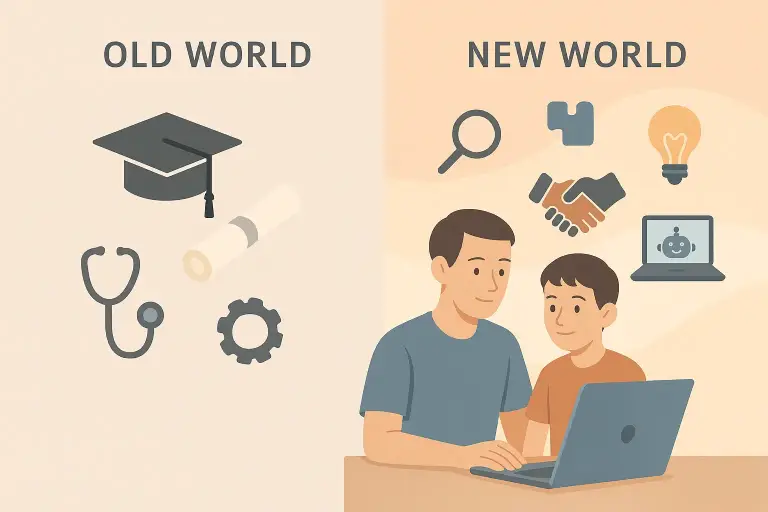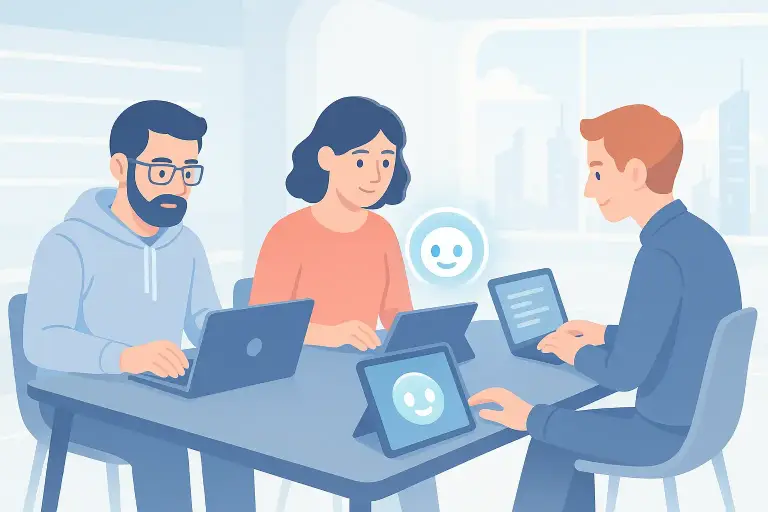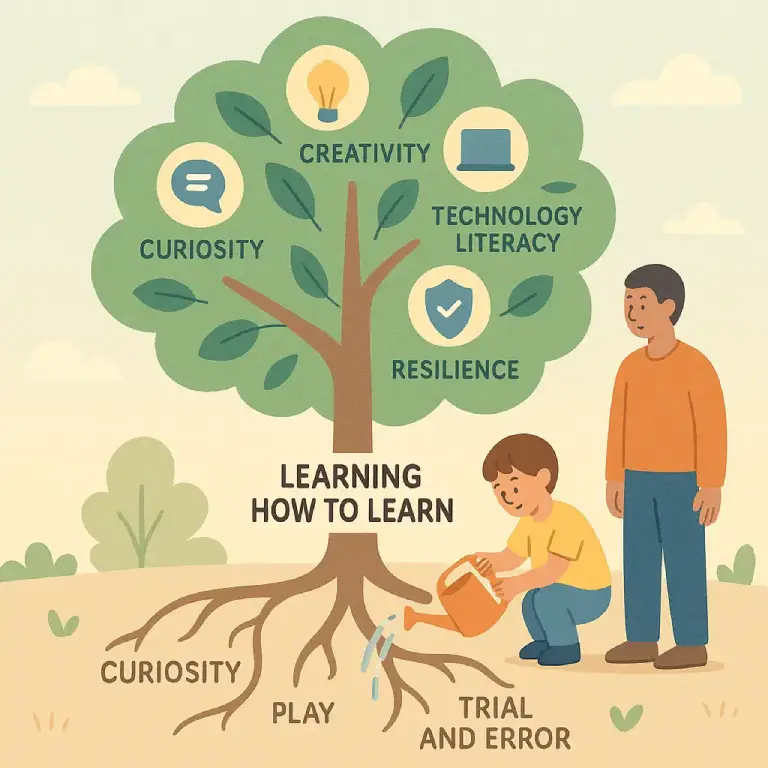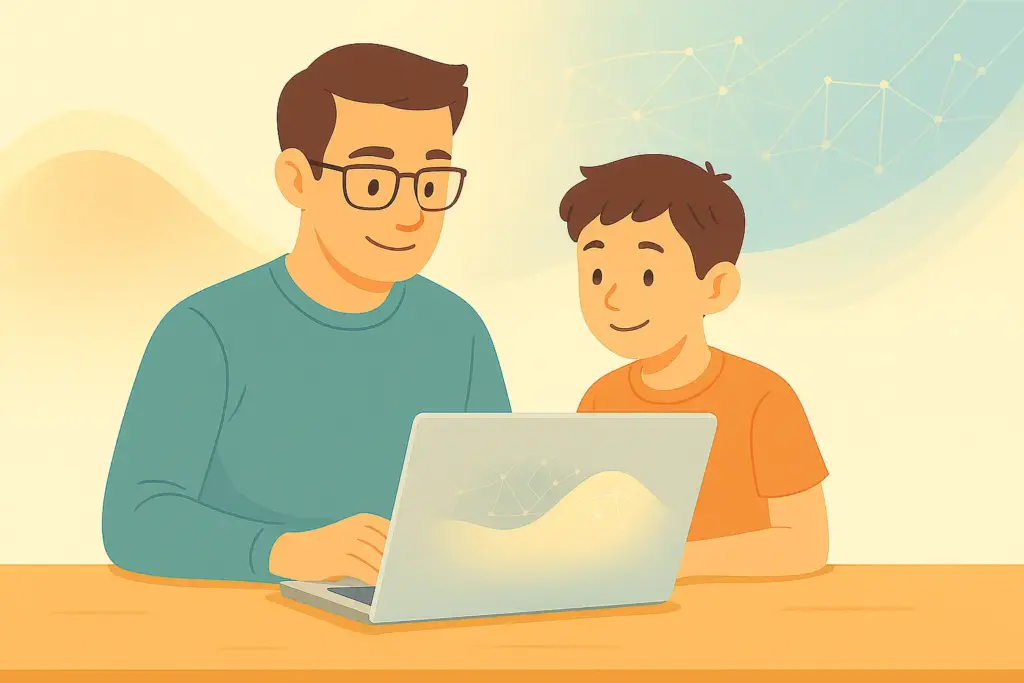On social media I usually share technical or work-related topics. But behind that “tech guy” image there’s also a dad with a 9-year-old son at home. Most of my day goes into software, data and, over the last few years, artificial intelligence tools. Like almost everyone, I use ChatGPT. But on top of that, I actively use – and even integrate – many other AI models into my personal and professional projects. For me, GPT-like systems are not “toys I play with from time to time”. They’ve become tools that sit right in the middle of my daily work.
Let me get one thing straight up front: I’m not a child psychologist. I’m not an expert in child development or parenting methods. This is not a pedagogical article. It’s written from the perspective of a technical person.
What I can say is this:
I see, from the inside, how artificial intelligence is already changing the way we work and the kind of people companies want to hire. And deep down I feel this:
If we prepare our children for the world we grew up in, we’ll be under-preparing them for the world they’re actually going to live in.
What Is Changing in the World of Work?
Let’s start with the big picture.
According to the World Economic Forum’s Future of Jobs 2025 report, almost 7 out of 10 employers now see analytical thinking as a core skill every employee should have. Right behind it come resilience, flexibility, leadership and social impact.
In plain language:
- Companies are moving away from “Which university? Which major?”
- And towards “How does this person think? Can they adapt as the job changes?”
A 2024 report by the OECD backs this up. In jobs that are exposed to AI, most employees don’t need to be AI engineers. But the skills expected from them are shifting anyway: management skills, business skills and digital literacy stand out.
A large academic study that looked at 12 million job postings (Mäkelä & Stephany, 2018–2023) also points to something interesting:
Demand and pay are going up for skills that “work well with AI”, and dropping for skills that AI can easily replace.
Digital literacy, teamwork, resilience are in the first group; shallow text checking and some basic customer service roles sit in the second.
Let’s put that big picture in our pocket and zoom in a bit. I’ll walk through the changes I see and experience directly.
Important detail: The examples here describe the current state of AI – and it reached this level in just a few years. Where it will be 3, 5 or 10 years from now is honestly hard to even imagine.

Software: One Senior + AI = a Small Team
I see the impact in software development first-hand. The change is very clear.
A typical scenario used to look like this:
- On a project, there would be one or two “senior” developers.
- Next to them, a few juniors, new hires, maybe an intern.
- Simple tasks, small bug fixes, tiny changes to existing code would go to the juniors.
- They would both get real work done and learn the trade.
Today, tools like GitHub Copilot, Cursor, Windmill, Codex and others have changed the picture.
While a developer is writing code, there is now a constant AI companion on the side of the screen: suggesting lines, completing missing blocks, offering example solutions. On top of that, we’ve reached the point where you can tell the tool what you need, let it write the code, and then come back and fix or adapt it.
Developers using these tools can complete certain tasks in almost half the time.
What does that actually mean?
A senior developer, with the help of AI, can effectively become a “one-person mini-team.” The AI writes code at around a junior level, but does it ten, maybe twenty times faster.
From a company’s point of view, the math is simple:
- Before: 1 senior + 3–4 juniors → certain amount of work.
- Now: 1–2 strong seniors + AI → the same amount of work, sometimes more.
Big, highly regulated companies may still be cautious about using AI at this level in critical systems, but the trend is clearly heading that way.
The result?
- Experienced developers become more valuable – but because their productivity increases, the number of seniors needed can actually go down.
- For young people entering the profession, the “start small and learn as you go” ladder is getting narrower.
If our child says, “I want to be a software developer,” this is the world they’ll be walking into:
They won’t just need to know how to write code. They’ll need to know how to define the problem, how to steer AI in the right direction, and how to design the system around it.
The era of “I’ll start as a junior and learn by doing small tasks” has entered a much tougher phase.

Content: From a 10-Person Agency to 3 People + AI
Blog posts, product descriptions, email campaigns, social media captions…
Today, AI touches a big chunk of this content.
In the past, a mid-sized content agency might have needed a 10-person team:
- Writers,
- Editors,
- Researchers,
- And juniors doing simpler tasks.
Now the picture is moving towards something like this:
- 2–3 strong editors,
- One person steering content strategy,
- The right AI tools plugged in beside them,
- And you still get the same overall output.
Most of the time, AI writes the first draft. The human side then:
- Adapts the tone to the brand,
- Cleans up errors and repetition,
- Decides who should hear what and when.
Even that part isn’t done 100% manually anymore; people often just tell the AI what to fix and let it handle the edits.
From the outside, it looks nice: productivity goes up.
From the job market’s perspective, it’s harsher:
- The same amount of work requires fewer content creators.
- A handful of editors who are good with AI can do what used to require a 10-person team.
- For “new writers”, entry-level opportunity space shrinks.
So in content too:
AI is a huge support for some people, and almost a barrier for others.
Design: Not the One Who “Draws Everything”, but the One Who Makes It Happen
The visual design world isn’t that different.
With DALL·E, Midjourney, Canva’s AI features and similar tools, things like:
- Social media visuals,
- Simple posters, campaign drafts,
- Website or mobile app screens,
are often created like this now:
- The designer explains the idea, mood, color palette and style.
- The AI generates dozens of options.
- The designer selects, refines and gets them ready.
So what does that mean?
The amount of variation that used to require 10 designers on a campaign can now be produced by one or two strong designers + AI.
Or to put it another way: a single designer who previously could realistically handle 1–2 brands can now stretch their capacity 4–5x.
Music: AI Tracks Climbing the Charts
I don’t work in the music industry. I’m just a listener. But even from the outside, you can see this:
There are songs that are fully AI-generated or heavily AI-assisted, and they’re getting millions of plays on platforms like Spotify and even reaching the top of certain charts.
So in music too, an artist who combines their talent with AI tools to compose, arrange and experiment with different styles is competing with someone who “just plays an instrument”.
You can guess the outcome:
- Talented + tech-savvy musicians pull ahead.
- People who say “I just play, the rest isn’t my business” have less room to stand in.
Customer Service and Call Centers
Logistics companies and e-commerce platforms now have chatbots that do much more than just reset passwords.
They can:
- Handle returns,
- Answer “Where is my package?” questions,
- Resolve many basic issues end-to-end without a human.
Even in difficult areas like healthcare, chatbots can:
- Provide information to patients,
- Support sales processes surprisingly far down the funnel.
In fact, I previously wrote an article about the chatbot project we developed at an health-tourism company.
I know how effective this can be because I’ve personally managed a project in this space.
The predictable outcome:
- Entry-level “customer representative” roles are under pressure.
- For example, instead of 40 agents, a company can deliver the same performance with 20.
For the positions that remain, expectations rise:
- Communication skills,
- Problem-solving,
- The ability to handle more complex, emotionally loaded cases.
Simple questions?
AI can already cover a good portion of those.
A Parenting Perspective: The Real Question Isn’t “Which Job?”
Across everything I’ve described so far, there’s a repeating pattern:
- For people who are experienced, keep learning and take ownership of their work, AI is a massive force multiplier.
- Competition between workers will get more aggressive, and because those people are more productive, the total number needed goes down.
- For people doing entry-level, repetitive, simple tasks, things were already hard and are getting harder.
AI is causing this level of change today.
When my 9-year-old son enters working life – 15 years from now – many of today’s jobs might not even exist in their current form.
So as a parent, I find it more honest to ask:
Instead of “Which profession should my son choose?”, I’d rather ask “Which skills should he learn so that he can keep updating himself for life?”
Recent reports back this up as well – and this is with today’s AI technology:
- Future of Jobs 2025 lists analytical thinking, creativity, resilience, leadership and self-awareness as core skills for the coming years.
- OECD and similar organizations say we need to look at a combination of human skills + digital literacy + business skills in the age of AI.
- That 12-million-posting academic study shows that people who develop AI-complementary skills are both in higher demand and get better pay.

From a parenting angle, here’s how it looks in my head. The skill set I’d like my son to build, beyond grades and even beyond “profession”, includes:
- Learning how to learn
- Problem-solving and seeing cause–effect relationships
- Technology literacy and the ability to work with AI
- Owning the work; motivation to follow through on goals
- Communication and empathy
A profession will be a kind of “shell” built on top of these. The shell can change. The core needs to stay solid.
Why Old Recipes Won’t Fully Work Anymore
When we were kids, the formula was pretty simple:
- A good school,
- A good department,
- A “secure” profession,
- A long career at one (maybe two) companies.
Today the picture is very different.
The WEF’s 2025 report says that by 2030, job roles will change significantly in a large portion of occupations: some roles will disappear while new ones emerge.
So:
- Old world: good school + good department = secure job
- New world: learning how to learn + adaptability + human skills = staying relevant and making a difference

So What Can We Do as Parents?
For me, everything boils down to one sentence:
I don’t want my son to be a spectator in a world shaped by AI. I want him to be someone who can take an active role in it and keep renewing himself.
Everything else – school choices, career plans, courses, hobbies – feels like details orbiting around this main idea.
Most of the work to build that skill set is, of course, in the realm of pedagogy. But when it comes to “technology literacy and the ability to work with AI”, that’s where I, as his father, want to take an active role.
I’m planning to work on this with my son Eren – small projects, experiments, shared learning – and I’ll share some of that journey on this blog over time.
As parents, the question in front of us is basically this:
Are we preparing our children for the next 10–20 years, or for the world we grew up in?
There’s no crystal-clear answer.
But pretending nothing is changing is definitely not the best starting point.





